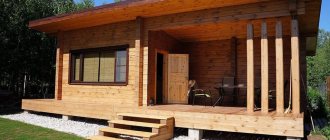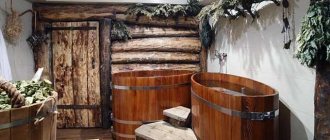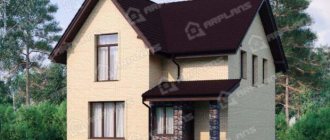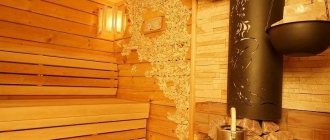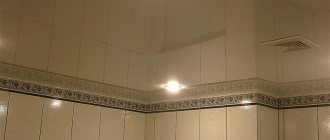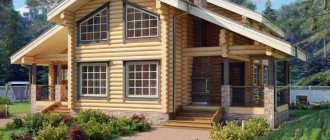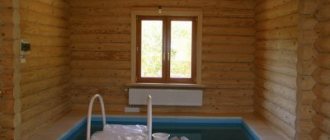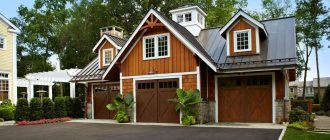Home » Type » Dacha
DachaDecorDesignWall Decoration
Alyona
Bathhouse projects with an attic are an opportunity to combine active water treatments on the ground floor and pleasant relaxation in the attic under the roof. The benefits of bath time are beyond doubt. After a steam room with a broom and a contrast shower, your well-being significantly improves - the body gains health, and the spirit becomes cheerful. The dream of having a spa at your own disposal with a relaxation room where you can spend time productively is becoming a reality.
Choosing a bathhouse project
A sauna with an attic is a double pleasure for connoisseurs of hot steam rooms. In order for an unusual structure to meet the tastes of the owner, as well as to be convenient and safe, a good, competent project is needed.
A bathhouse is an opportunity to combine business with pleasure
A bathhouse with an attic is a technically complex object . The design solution must take into account the features associated with the arrangement of additional premises. A full-fledged construction project contains sketch and architectural parts, structural and engineering sections, and financial documentation.
A set of drawings and descriptions developed by professionals will help to properly prepare and organize construction, establish communications, and ensure the safety of vacationers.
Double pleasure for hot steam room connoisseurs
The architectural part of the bathhouse project gives a visual representation of the facades of the building, zoning, and the composition of the interior. You can choose a compact building for a family holiday or a large-scale structure for leisure in a large company.
Projects are developed by specialized organizations. Construction sites offer a variety of solutions. The owner of the estate can choose an option taking into account his taste and the actual conditions of the site.
Exterior decoration of the bathhouse
A bathhouse built in a picturesque location needs appropriate external decoration. If this is a log house, no additional cladding is required, because hardly anyone will question the aesthetics of natural wood. But such a structure definitely needs caulking - filling the space at the joints with moss or tow.
Log bathhouse
Log caulking
Caulking a log house - before and after
Next we move on to sanding the wood surface and treating it with a special impregnation for wood, which will significantly increase the service life of the natural material.
The process of applying impregnation can be greatly simplified if you use a special sprayer
The exterior decoration of a bathhouse with an attic also includes:
- installation of cornices and edges;
- arrangement of drains and walkways;
- basement finishing.
For options for a bathhouse built from brick or foam blocks, there are different elements of external cladding. It can be made from lining, siding, artificial stone or block house (imitation of rounded timber). The imitation of timber looks interesting, and this option will help to significantly reduce costs. And window openings are often decorated with carved elements, giving a bathhouse with an attic an original Russian flavor and aesthetic completeness.
Video - Painting a log house
Advantages
An attic is a room under a roof intended for temporary or permanent residence. The first attic rooms appeared in France and were used to house servants.
This is a technically complex object
François Mansart, a famous architect, transformed the attic space, decorating it with large windows and an original shaped roof. Since then, attics have gained popularity. They began to be built in both economy-class buildings and luxury apartments. The premises contain bedrooms, rooms for relaxing or receiving guests.
The attic in the bathhouse is an additional area that can be equipped for comfortable relaxation in the warm months of the year and in the winter cold.
The undoubted advantages are:
- ease of construction - no need to build a foundation or walls;
- efficiency - a full-fledged room based on an existing building is much cheaper than a separate building;
- basic communications have already been carried out;
- the attic creates additional thermal protection for the lower floor, this is especially noticeable in winter;
- The best part is that you don’t have to leave the bathhouse to lie down or chat with friends.
The construction project contains sketch and architectural parts
A beautifully decorated attic will emphasize the style and add uniqueness to the architectural appearance of the building.
Types of attics
Attic spaces are distinguished by a variety of design solutions:
- for the installation of attics, single-pitched, gable, hipped, hip and half-hip roofs are used;
- thanks to the broken silhouette of the roof, the walls and ceilings have different slopes;
- the attic can occupy space above the main building or extend beyond it in the form of a console;
- with reliable roof insulation, the room will be suitable for habitation all year round; with a cold roof, it can be used in the summer;
- The material of the supporting structures, as a rule, corresponds to the base building; in bathhouses, beams are usually made of wood.
The attic in the bathhouse is additional space
The design can be one- or two-level, with a balcony equipped with sloping dormer or vertical gable windows.
The finishing uses materials and techniques that are functionally and aesthetically compatible with the design of the bathhouse.
Types of baths with an attic
Traditional materials are used to build baths:
- beam;
- log;
- clay brick.
And modern ones:
- foam blocks;
- expanded clay concrete;
- OSB.
A bathhouse is an opportunity to combine business with pleasure
Popular in decoration:
- lining;
- ceramic tile;
- stone;
- decorative moisture-resistant panels.
A real bathhouse must have a steam room.
In addition, you cannot do without:
- dressing room;
- washing;
- shower;
- furnace or boiler room.
More comprehensive options are offered additionally:
- rest rooms;
- bathroom;
- kitchen;
- billiard room;
- pool;
- terrace;
- barbecue area.
These are entire complexes for complete leisure with family or friends.
Easy to build
Timber
Timber is a traditional material for the construction of baths. Wood has a unique ability to “breathe” with fluctuations in humidity and temperature. It is warm, environmentally friendly and, importantly, affordable for construction.
The buildings are made of solid or laminated timber. The latter is considered a higher quality material, as it is not prone to drying out, deformation and cracking.
As a rule, bathhouses are built as single-story, free-standing ones. But recently, two-story and attic options have become widespread, as well as those interconnected with a garage or house. This arrangement is convenient for water supply to steam rooms and wastewater disposal.
The attic creates additional thermal protection for the lower floor
Baths made of profiled timber are often made in Russian or Scandinavian style. Wood is traditionally widely used in these areas. Log frames or vertical cladding of walls are characteristic features of buildings in timber-rich countries.
Log
A log bathhouse is a traditional Russian log house made from whole logs with a modern “filling”. Healing air, saturated with the aroma of the forest, and the amenities of civilization - a shower, a swimming pool, a bathroom - create a comfortable environment.
Saunas made from rounded logs are not cheap. The wood is prepared for construction - it is impregnated with antiseptics, slots are cut for fastening the elements together, and the surface is polished until smooth.
Traditional materials are used to build baths
Log houses look very impressive both outside and inside . The walls are often not covered, leaving the wood in its original form. The most popular buildings are 3x3 m, 4x4 m.
From foam blocks
Foam blocks are a relatively new material that is widely used for the construction of baths. It is light, warm, and easy to process. Thanks to the low price, the facilities are budget-friendly and affordable for many who like to take a steam bath.
The blocks are strong enough to withstand the load from the attic. Any finish is compatible with them. The main thing is to protect the material from waterlogging and low temperatures. To do this, it is carefully isolated from external and internal destructive factors.
Such a structure will not take much time
Foam block baths are lined with wood, brick, decorative panels, and various types of siding. The architectural style can be anything from traditional folk to unusual.
Frame baths
Frame baths are quickly built, inexpensive, and provide the necessary comfortable microclimate in the room. The basis is a frame made of boards, with insulation placed in the spaces between them. As a rule, this is mineral wool.
The foundation is a shallow strip or columnar foundation. Such a base can be made independently, without the involvement of earthmoving and construction equipment.
The inside walls are lined with clapboard made of pine, cedar, linden or valuable wood. Exterior finishes must withstand frost and moisture.
Frame baths are quickly built, inexpensive, provide the necessary comfortable
A frame bathhouse with an attic, finished with a blockhouse, looks stylish . Imitation of timber creates a realistic feeling that the walls are made of solid wood.
Thanks to new technologies and building materials, the negative impact of high humidity and temperature on the structures and decoration of premises is completely eliminated.
Project of a 6x6 bathhouse made of profiled timber
A bathhouse made of 6x6 profiled timber with an attic has become popular recently, this is mainly due to the high performance properties of the material. Here we can also add less time and labor required to create a drawing of such a bathhouse and its construction, which 6 by 6 bathhouse projects with a log attic do not have. The attractiveness of such a design can be made through the use of different types of facing materials.
The diagram shows common designs of bathhouses with a 6x6 attic
The above project of a 6x6 bathhouse with an attic made of timber provides for the presence of a terrace from which you enter a small room in which there will be a corridor, and from there a relaxation room or dressing room opens up.
From the corridor you can also go up to the second floor by stairs.
- The area of the dressing room is designed so that in this room you can place a hanger for clothes, which you will take off before heading to the steam room. There will also be a small supply of firewood for the sauna stove;
- From the dressing room the door leads to the washing room, and then to the steam room. In the washing room you can place a shower with a tray and a hot water tank;
- The steam room will house a fireplace stove, which will be heated from the relaxation room of the bathhouse. Moreover, the entrance to the rest room is arranged directly from the dressing room. This was done to ensure that the humidity in this room was not too high;
Window in the steam room
Note! In the washing room and in the steam room there are usually windows with small dimensions - 50 by 50 cm, but in the rest room the window is often quite large - 120 by 100 cm. This was done so that more sunlight enters this room. This will create natural light and also allow you to enjoy the beautiful view from the window.
- Doors in such a structure can be installed in any size. The main thing is to choose the right material for them so that it is durable, allows heat to remain in a given room for as long as possible and can well withstand the effects of moisture;
Advice! It is advisable to make doors smaller than conventional door structures. This is due to the fact that a small door will contribute to better heat retention. The most optimal size for a bath door is a height of no more than 180 cm and a width of no more than 70 cm.
Bath doors
Two-story baths with veranda and balcony
Most often, designs for a 6x6 bathhouse with an attic can be seen from a log house made of logs or timber. As for frame baths of this size, there are very few of them now. The difference between these buildings is the price and the material used for construction.
Design with a corner veranda
The project below presents a two-story building, here there is a terrace on the first floor, and a balcony is provided on the second floor.
Common ground floor option
This project for a log house 6x6 bathhouse with an attic has the following solutions:
- such a structure must be installed on a columnar foundation;
- the height of the ceilings on the first floor of the bathhouse and the second is almost the same (on the first floor - 2.25 m, and on the second - 2.20 m);
- since the overall dimensions of the washing room and steam room are not significant, it would be more appropriate to place the bathroom in the relaxation room;
- You can climb to the top via the stairs that lead from the rest room. It is equipped under a gable roof. The building system in this case is mounted from timber 5 by 10 cm;
- The roof of such a structure is planned to be covered with Euro slate, as a result of which a sheathing is created along the rafters from 20 mm edged boards. Glass wool will be used as insulation;
Second floor
Advice! It is better to make the door leading to the balcony glazed. This will allow you to additionally ensure the flow of sunlight into this room. On the 19 m2 of the second floor there is one small window, which is located above the stairs, and it may not be enough for full lighting.
Construction of a two-story bathhouse from rounded logs
Compared to structures built from other materials, such a structure has many advantages, including the ideal fit of the logs to each other. This reduces the use of manual labor and the time required for construction work.
Made from logs
In addition, due to the ideal shape of the logs, a better density of connections between all elements of the log house is achieved, as a result of which the percentage of its strength and thermal insulation increases. Material deformation is reduced to a minimum.
Such a bathhouse, built with your own hands, has an excellent appearance, which allows you to do without the interior and exterior decoration of this building. And its service life is much longer than that of a structure built from timber.
Quite an interesting object
The construction of a bathhouse from such material is considered more economical.
On the ground floor of such a building you can place anything you want, but, as a rule, it is necessary to equip it with:
- steam room;
- rest room;
- bathroom;
- shower;
- dressing room
In this matter, everything depends on the preferences of the owner.
You can live in such a building
Brick
Brick is a durable fire-resistant material. Thanks to these advantages, baths made from it are quite popular. Capital buildings serve for more than 50 years without rotting or being damaged by insects.
Brick is a durable fire-resistant material
You can use brick to build a small bathhouse 3x3 meters or build a structure of complex shape. Only ceramic clay material is used; it meets all sanitary, hygienic and construction requirements for buildings with increased flammability.
The brick baths with an attic are solid and solid. Their design requires special attention. The thickness of the walls is greater than that of wooden, foam concrete or frame analogues. For heavy structures, a massive foundation is erected.
Roof installation
The attic is located directly under the roof, but for its correct installation it is necessary to calculate the parameters of the supporting structures as accurately as possible.
- The height of the second floor wall before the roof begins to slope is usually no more than one and a half meters.
- The angle of inclination of the rafters can vary from 30 to 60 degrees, depending on the project. The lower the degree of inclination, the more usable area there will be in the attic.
- The width of the room should be about three meters, and its height at the highest point should be up to 2.2 m.
The broken roof of a bathhouse with an attic is a rather complex multi-layer structure. For ease of installation of rafters, auxiliary scaffolding is placed in the central part. First, the rafters are fastened near the gables, and a cord is pulled along the ridge to control the level of the rafters. Next, with a distance of 60 cm between each other, the remaining rafters are mounted.
Broken mansard roof: determining proportions
Sloping roof Sloping roof rafters
Additional wooden beams simultaneously serve as the basis of the attic ceiling and strengthen the roof rafters, and the wall frame is made of vertical posts. An important nuance is that the height of the racks must be at least 100 cm higher than the planned “finished” ceiling.
Video - Installing a sloping roof
From the outside, the roof structure is covered with fire-resistant insulation and fixed with a lathing made of wooden beams. The density of the insulation must be at least 35 kg/m3 in order to preserve the geometric shape of the heat-insulating material as much as possible and protect it on the slopes from shrinkage and pressing.
An additional layer of vapor barrier film is laid on the inside of the roof surface. At the same time, it is advisable to leave 5 cm of free space between it and the roof for ventilation. If metal tiles are chosen for further covering, the lathing pitch should be no more than 35 cm.
Prices for metal tiles
metal tiles
Video - Construction of a bathhouse roof
Vertical attic windows are usually located at a distance of 65-95 cm from the floor, and additional (sloping) ones can be installed directly in the roof system. To do this, at the installation stage of the rafters, the places for future windows are fixed with transverse bars. It is believed that the optimal ratio of walls and attic windows is 8 to 1 - in this way the most favorable microclimate will be maintained on the second floor.
Layout of a site with a house and a bathhouse
The location of the steam room on the site is subject to fire and sanitary safety requirements, as well as those related to convenient connection to communications.
Pay close attention to fire safety
When planning a place for a bathhouse, take into account:
- Construction material . If the structure is wooden, the distance to the neighboring house should not be less than 10-15 m.
- Fuel . If the bathhouse is supposed to be heated with wood, 5 m are removed from the fence, and 2.5 m with gas.
- Availability of central sewerage . If it is not there, at least 8 m away from a residential building, well or cellar.
- Red line . The distance from it to any building on the site is at least 5 m.
For the most favorable illumination by the sun and saving energy resources, it is advisable to locate the bathhouse in the northern or northwestern part of the site.
Small, economical option
Room layout
Ready-made projects offer convenient zoning of the building area. The premises in the baths are divided into sections:
- water procedures - washing room, steam room, sauna, shower, swimming pool, jacuzzi;
- for relaxation - dressing room, living room, bedroom, billiard room, terrace, gym, solarium, herbal bar;
- auxiliary - locker room, kitchen, vestibule;
- technical - furnace, boiler room, firewood storage, place for drying brooms, laundry.
Ready-made projects offer convenient zoning of the building area
The premises must be conveniently located and properly communicate with each other. The washroom is preceded by a dressing room and a dressing room, from which you can go to the steam room or swimming pool. For winter use, an additional vestibule is installed in the bathhouse, which prevents the penetration of cold air and the appearance of drafts.
The steam room, shower and washroom must have a separate entrance. Technical rooms are separated from the rest. The bedroom or lounge is located in the attic, reached by a staircase. It is equipped with stable railings and non-slip steps. If the bathhouse has a swimming pool, it is combined with rooms for water procedures and access to the terrace.
The premises in the bathhouse should be divided into sections
What could happen in such a project?
The choice of premises depends on the personal preferences of the owners. When planning a 6x6 bath house, the rooms usually have the following purposes:
- Rest room;
- Gym;
- Dinner Zone;
- Small cinema;
- Bar;
- Workshop;
- Living space, bedroom.
On the ground floor you can place a dressing room, a washing room with a plunge pool, a vestibule with access to the terrace, a small dining area, a steam room, and a relaxation room. On the second there are a couple of rooms with a door opening onto the balcony.
You may be interested in: Layout of a house with an attic: advantages and important points
Wooden buildings encourage people to use them for permanent residence. Wood has the ability to saturate the room with life-giving air, which helps people get the most out of the city. This is noticeable from the first seconds of being inside.
Premises equipment
A stove and shelves are placed in the steam room. Screens must be installed to protect against fire, and people must be protected from getting burns.
In a shower room equipped with running water, a stall or corner is installed. If this is not possible, and the water is heated in the tank, then the shower is replaced with a large ladle or a vertical watering can on a support.
The bathroom is located in the boiler room or separately. You can use a bio-toilet or organize a full-fledged toilet if there is a sewerage system.
A stove and shelves are placed in the steam room
In a small bathhouse, you can combine a washroom with a steam room, without separating them with partitions, and dispense with the bathroom.
The dressing room in small buildings serves as a locker room, resting place, and firewood storage. Even a modest-sized room is furnished with the necessary furniture: a bench or sofa, a hanger, shelves for shoes, a table.
If possible, separate the dressing room and dressing room, and move the rest room to the attic. If desired, a billiard table, upholstered furniture, and a fireplace can be installed there.
The area of the bathhouse is calculated from the estimated number of visitors simultaneously taking water procedures. Each person is allocated 5 m².
Option for a rest room
A well-thought-out layout is the key to a comfortable and, most importantly, safe stay.
Finished projects
When evaluating finished bathhouse projects, it is easier to imagine what exactly you want to see in your personal project. Below is a project for a bathhouse with an attic; if you build such a solution from a log house, it will turn out very beautiful. The drawing shows that the ground floor has all the necessary premises. The sauna's steam room can easily accommodate 7 people. The entrance to the steam room is through the shower; there is a separate door to the bathroom. The ground floor also has a small veranda and a nice common room. A staircase leads from it to the attic. The attic is divided into two identical rooms. They can be used as living rooms above the bathhouse or as recreation rooms. There is also a balcony where you can drink a cup of herbal tea.
Below is another interesting bathhouse project, which can be assembled from a log house or using the frame method. This bathhouse has both a veranda and an attic. But the bathhouse project does not have a bathroom. You can allocate a place for it in the rest room, which is located below. The space will be compensated by the fact that there is another large room at the top of the bathhouse. The attic can be used for various purposes.
If the area for building a bathhouse is limited, then you can evaluate the design of a bathhouse with dimensions of 6 by 4 meters, which is given below. This bathhouse has everything you need and even has a veranda. Four people can be in the steam room at the same time, or the same number can wait their turn in the relaxation room. There is a shower in the bathhouse, in which you can also put a toilet, placing it behind a small partition. On the veranda you can place benches or sofas, as well as swings. The process of building a bathhouse with an attic from a log house can be clearly assessed in the video at the end of the article.
Types of steam rooms
In a steam room, a person is exposed to dry or wet steam and high temperature. The body reacts to this with rapid breathing, increased sweating, and active work of all organs. That is why after visiting the bathhouse you feel a feeling of lightness, liberation from accumulated fatigue.
Despite the general principle underlying pairs, there are a sufficient number of their varieties in the world:
- Finnish sauna - dry heating of stones is carried out with firewood and electric heating elements. A compact option is infrared emitters that raise the temperature of surfaces. After acceptance of the procedure, they move to the washing room.
- A traditional Russian steam room - a stove-heater heats up to a high temperature when burning wood. To humidify the air, hot stones are periodically watered with water, herbal infusions, and kvass. Birch, juniper, rowan, oak and even bamboo brooms are used for massage. Herbs and shrubs rich in essential oils are suitable for this purpose.
Finnish sauna - dry heating of stones using wood
- Turkish hammam - heat is supplied from a heated pipeline running in the walls along the perimeter of the room. The temperature does not exceed 55°, which is comfortable for people who cannot tolerate heat. Steam is released through special channels at a height of 1.5 m. The decoration is dominated by marble, natural stone and tiles.
- A Japanese bath is a barrel-shaped font filled with water heated to 45° with the addition of essential oils, salts, and herbal extracts. A person sits inside on a bench for 15 minutes, followed by a massage and warming up in a container filled with a mixture of hot cedar sawdust and pebbles. The popularity of such steam rooms is growing.
Traditional Russian steam room
Construction technology
Building a bathhouse, like any other structure, requires professionalism, so if you just have an idea and are good with tools, but are not a highly qualified professional. We advise you to buy a log house disassembled and save money by assembling it yourself.
Laying the foundation
- Naturally, the first thing to start with is building a foundation. The foundation can be laid strip, strip-column or columnar, depending on the condition of the soil on the site. We will build a bathhouse from profiled timber or logs, and wood is a relatively light material, so a shallow foundation is sufficient.
- We mark the territory using pegs and stretched fishing line. After this, we select the soil to a depth of half a meter. We make the width of the foundation about 30 - 40 cm, plus the thickness of the formwork.
- At the bottom we make a cushion of sand or crushed stone 100 - 150 mm and lay the reinforcement frame.
Foundation with laid columns.
Important: when installing a reinforcement frame, the corners of the frame should be bent, that is, take about 2 m of reinforcement, bend it in the middle at 90˚ and lay it down. If you simply tie the reinforcement, the corner may crack later.
- Next, pour the concrete and let it sit for at least 1 month. To support the walls, intermediate columns should be poured in increments of 1 - 1.5 m. To do this, we use a drill to select soil to a depth of 0.5m - 1m, make a cushion, insert a pipe rolled from roofing felt, reinforce it and fill it with concrete.
Walling
- Before starting installation, you should arrange reliable waterproofing. To do this, we lay roofing material on a concrete foundation in at least 2 layers. We mount the harness and crowns on it.
- When purchasing a finished log house, it is obligatory to plan it, in other words, all the parts are numbered and there are instructions - what, why and where to install it, so we won’t stop here.
Installation of walls made of profiled timber.
Floor installation
- A floor on the ground for wooden buildings is not that difficult to construct. A cushion is made of gravel with sand, or dump slag, 200 mm above the ground level. A 40x40 mm cranial beam is placed on the bottom side of the logs, onto which strips of unedged boards or slabs are laid. Waterproofing, usually polyethylene film, is laid on it. The entire forest is impregnated with a protective solution.
- Next, we lay insulation for the bath between the joists and cover it with another layer of waterproofing. A gap of 10 - 15 mm is left between the top layer of waterproofing and the finishing floor. After this, the floorboard or slab flooring is installed.
- But in the steam room and washing room it is better to make a monolithic screed and cover it with tiles. Since we are dealing with rooms with high humidity, plus the temperature in the steam room is high, traditional insulation materials are not suitable here.
- You can waterproof the logs well, make backfill just under the logs, lay waterproofing, install a reinforcement cage and pour screed along the beacons.
- Or lay waterproofing on the backfill, then fill the space up to the upper level of the log with expanded clay. Place foil on top as waterproofing and sew a slab flooring made of moisture-resistant CSP boards onto it. You can lay tiles on the slabs.
- The most convenient option is to install a shower stall in the washing room.
- There are wooden ladders on the tiled floor, which can be easily removed and washed.
Option for arranging the floor in a steam room or washing room.
Important: it is recommended to install special insulation for baths in the steam room, but its price is significant; if there is not enough money for it, then foil is simply placed in the walls of wooden buildings. Because at high temperatures, traditional insulation begins to break down and release harmful fumes.
Floor installation
Insulation of the ceiling.
- The arrangement of the interfloor ceiling of a bathhouse with an attic and a terrace is similar to the arrangement of the floor. But there are small changes.
- A sheathing of edged boards is placed on the ceiling joists from below; it will be convenient to mount a bathhouse ceiling made of clapboard on it. A vapor barrier is laid on top, thermal insulation is laid on it, covered with another layer of vapor barrier and, leaving a gap for ventilation, the finishing coating is laid. You can put a foam pad under the joists for sound insulation.
- The insulation above the steam room is done a little differently. On the load-bearing logs, an edged board is also tacked from below, which is sheathed with foil and clapboard. Geotextiles are laid on top. High-quality expanded clay is poured onto it into the opening between the joists, covered with a vapor barrier and, leaving a gap for ventilation, the finishing coating is laid.
- Instead of expanded clay, you can use sawdust mixed with cement. A can of about 1.5 liters of cement is poured into 2 buckets of sawdust and, adding water, it is mixed with a mixer until it is wet. The composition should not be wet, it should be loose and moist. The price of this composition is scanty, but the effect is acceptable.
Overlap diagram.
Important: when removing the pipe, a metal box is made at the interfloor passage and filled with expanded clay. Take high-quality expanded clay, such as Knauf, because at high temperatures, poor expanded clay can emit harmful gases.
- On the roof, the rafters are sheathed on top with lathing, on which a hydraulic barrier is laid and slate or metal tiles are mounted. A layer of vapor barrier is sewn underneath, insulation is laid between the rafters and fixed with another layer of vapor barrier. Next, you can fill the sheathing and attach the lining to it.
Advice: when lining a steam room, it is best to use first-class linden lining; this is the most optimal and healthy option.
Interior Design
To get true pleasure from bathing procedures, the surrounding space must be correctly arranged, and the finishing must be of high quality and beautiful.
Decoration Materials
A steam room is a place where temperature and humidity constantly change. For finishing, lining made of non-resinous wood is recommended. The walls and ceiling are sheathed with boards, placing them vertically, horizontally and at an angle. Impregnation with protective compounds is required.
Turkish hammam
Stone, porcelain stoneware, and facing bricks are used to finish the floors and walls behind the stove. The materials are not flammable, do not rot, and do not deform from fluctuations in temperature and humidity.
Illuminated salt panels will decorate the interior and saturate the air with healing vapors. It is advisable to arrange such finishing in dry steam rooms - water has an adverse effect on the material.
Mosaic marble panels are used to decorate surfaces in Turkish hammams; such cladding is not typical for Russian or Finnish baths.
The temperature in the shower is lower than in the steam room, but the humidity is high. Stone, tile and wood can be complemented with:
- moisture-resistant plasterboard;
- plaster;
- PVC panels.
Japanese bath
The dressing room and attic rooms do not come into direct contact with water. Any options and combinations are possible for their finishing. It is recommended to cover the surface bordering the steam room with brick, stone or plaster without the use of wood. The accumulation of condensation destroys the wood.
Furniture
Furniture plays a big role in the design of rooms. Wooden carved details will enrich the interior of a bathhouse or attic, and original hangers and benches made from solid logs will add a touch of closeness to nature.
For the safety of people, furniture should be stable, but not bulky. Surfaces must be carefully processed until smooth to avoid splinters or scratches.
Japanese style lounge
Bathhouse project with a terrace or veranda
In suburban construction, the layout of a bathhouse with a terrace or veranda is common. The main building is made using any chosen technology - brick, foam blocks, timber, logs.
Terrace is a platform with a deck for relaxation next to the main building. She is satisfied with:
- adjacent to the front or side wall;
- under a common roof or separately, connecting a path with the entrance;
- open or fenced.
Option with terrace
On the terrace or next to it, an area is allocated for a barbecue or grill. To ensure fire safety, all places where sparks can get are protected with fireproof materials.
The terrace covering is made of boards, ceramic non-slip tiles, concrete or stone. The playground is equipped with furniture - a table, plastic or wicker chairs, swings, sun loungers.
Lighting should be provided in the evening. For this purpose, LED lights, garden lanterns, and stationary lighting fixtures are used.
On the terrace you can place a font for taking baths. To protect from prying eyes, lattice supports are installed and climbing plants are planted.
The veranda will not be superfluous
Why do you need an attic in a bathhouse?
The attic is a room with a sloping ceiling. This unusual appearance of the room makes it especially cozy and comfortable. Initially, attics were preferred by people of creative professions; in such a quiet, bright and cozy room they were inspired and relaxed. Today, an attic is not a luxury, but an opportunity to rationally use space.
The advantage of bathhouse projects with an attic is that you can place anything in this room! Many people decorate their bedroom here. It is enough to place a bed in the room, and you can stay here overnight, and if there is a house on the territory, then the attic can serve as a guest room.
We recommend reading:
Bathhouse projects with a terrace: photos, layout, examples, features and nuances
Some people make a bar here: they put a bar counter, a billiard table, cozy sofas and a TV. In such a room it is pleasant to relax after bath procedures.
Another option is to make a place for a SPA; for this you need to install a massage table, a massage chair, a solarium, and a cabinet with aromatic oils.
If the attic turns out to be quite spacious, then it can be divided into several rooms, making, for example, two bedrooms or adding a bathroom. A cozy balcony would also be a good option.
An example of a 6 by 6 bathhouse project with an attic
The structure is made of profiled timber, square in plan, sufficient in area to accommodate a washing room, steam room, boiler room, vestibule, covered terrace and rest room. From here a staircase leads to the attic. The attic space is insulated; a bedroom or billiard room is planned there.
The foundation is shallow. The basement, porch and chimney are lined with brick. The roof is gable, covered with flexible tiles.
On the facade, the windows have a complex trapezoidal shape, emphasizing the slope of the roof. Stone steps lead to the terrace. The fencing is made of planks, repeating the texture and color of the profiled timber. To support the roof, a wooden column decorated with carved ornaments was installed. Firewood is stored under a shed next to the boiler room, with a separate entrance leading from it.
Projects of bathhouses with a 6x6 attic: examples of how to draw up a drawing correctly
Before starting design, you need to decide on the place where the bathhouse will be located. The best option is next to a body of water. In this case, the project can include a veranda with a descent into the water, then after warming up in the steam room you can cool down in a pond, lake or river.
If there is no body of water nearby, then pay attention to the designs of bathhouses with a swimming pool. Due to the fact that you can buy a bowl ready for installation, the construction of such a bath will be quite inexpensive.
Having decided on the location, you can draw up a design for a 6x6 bathhouse. Any bathhouse must have a steam room, a washing room and a relaxation room.
The steam room is the “heart” of the bathhouse. There should be enough space so that vacationers can comfortably stay in this room. But you shouldn’t make the steam room too spacious, since increasing the area of the room increases fuel consumption and the heating time of the steam room. The minimum size of the steam room is 2 square meters. A 6 by 6 bathhouse design usually includes a steam room measuring about 5 square meters. In the steam room you need to place shelves in several tiers and a stove.
We recommend reading:
Bathhouse project 3 by 5 m: photos, examples. How to design a 3x5 bathhouse?
The washing room is also a necessary room for a bathhouse. They take a shower in it after warming up in the steam room, and women carry out cosmetic procedures: apply creams, lotions, scrubs, etc. There are no strict requirements for the size of the washing room: it can be about 1 square meter so that a shower stall can fit in it . Another option is a more spacious room, the size of a steam room. In this case, you can make several showers in it, put a bench, place basins, tubs, etc. If you make a spacious washing room, then you can put a font or a small pool in it.
The rest room is the largest room in the bathhouse; the entire company that came to the bathhouse should fit in it. In this room you need to place a table and places to sit. Additionally, the room has a TV, a tape recorder, a billiard table and a kitchenette. If the project does not provide for a vestibule, then in the rest room you need to organize an area where you can leave outerwear and shoes. It is recommended that the size of the relaxation room be at least 10 square meters; in a 6 by 6 bathhouse you can make it more spacious - about 16 square meters.
A vestibule is an optional room, but it is desirable to have it. The dressing room is used to store clothes, shoes, household items and logs for the bath. The size of the dressing room can be any, depending on the project.
It’s a good option if you can manipulate the stove in the dressing room (heat it, regulate the temperature).
The 6 by 6 bathhouse project has quite spacious dimensions, so you can choose a project with additional rooms, for example, a bathroom. A toilet in a bathhouse is not necessary, but it is especially important in winter, since you are unlikely to want to run across the street to a separate toilet in the cold.
An excellent option would be a bathhouse project with a terrace. The terrace allows you to relax outdoors not only in good weather, but also in rain. It is much more pleasant to relax between trips to the steam room not indoors, but outdoors, where nature and clean air are all around.
The second floor can be decorated in different ways. The easiest option is to leave one spacious room. But this is not always a good option, especially if you are staying overnight with a group. You can make two small separate rooms.
Another option is a room and a balcony. A small balcony allows you to create a cozy place to relax alone or as a couple. It can have a small area, the main thing is that two chairs and a miniature table fit on the balcony.
We recommend reading:
Bathhouse projects with barbecue: advantages, layout, construction features and photos
Project of a 6x6 bathhouse with an attic and a terrace
The project is quite simple to implement. On the ground floor there are the main rooms: a compact steam room, a small washing room and a spacious lounge. There is also a terrace in the bathhouse where you can drink tea and relax.
The entire second floor is one spacious bedroom. Here you can make a second rest room or place beds and sofas. The bedroom area is almost 30 square meters, so it can easily accommodate a large company.
Project of a 6 by 6 bathhouse with an attic, a terrace and a dressing room
The bathhouse design provides for the presence of a small terrace and a washing room; they have the same size - 3.75 square meters. The spacious recreation room has enough space to accommodate the whole company; it also has a staircase to the second floor.
The project provides a vestibule where clothes, shoes, fuel and other materials can easily fit. On a summer day, you can sit on the spacious terrace, which measures 9 square meters. You can put a table, benches on it and have a picnic.
The entire second floor is occupied by a spacious bedroom (27 square meters).
Project of a 6x6 bathhouse with an attic, terrace and balcony
On the ground floor of the bathhouse there is a steam room, a washing room, a relaxation room and a terrace. The steam room measures 4.37 square meters and is designed for approximately 4 people. Between the steam room and the relaxation room there is a washing room, slightly smaller in size - 3.44 square meters.
On the second floor there is a second lounge and a small balcony.
Project of a 6 by 6 bathhouse with an attic and a bathroom
This project is similar to the previous one, but there is no terrace, and instead there is a small bathroom. If you don’t have a toilet on your site or are building a bathhouse far from it, then this project will be the best option.
Project of a bath house with an attic, a bathroom and a terrace
The advantage of this project is that in this case you get not just a bathhouse, but a full-fledged country house where you can stay overnight. On the ground floor of the bathhouse there is a small elongated terrace. Next you find yourself in a spacious hall. Doors lead from it to the bathroom and shower room. You can get to the steam room through the washing room.
The entire second floor is occupied by a bedroom. In this project, all objects are placed quite conveniently. You can make a sauna stove near the wall between the steam room and the hall, in which case it will be convenient to control the temperature inside the steam room.
A 6 by 6 bathhouse project with an attic is a popular option that has a number of advantages. It is possible to build such a bathhouse quite economically, while it will be comfortable to use and will have good capacity.
Unusual baths
A person’s love for bathing is embodied in unusual ideas. The desire to steam in any environment is irresistible, so designers have developed exotic and daring wonders:
- Bath-tram - in the trailer in Milan there is a steam room for 10 people. The interior is decorated with a plasma screen, where videos about the history of trams are played non-stop.
- Steam sauna - on Lake Larsmo in Finland you can steam in a sauna floating on the waves.
- Lift sauna - a small mobile capsule in the mountains of Finland can accommodate 4 people.
VIDEO: Built bathhouse projects
Bathhouse 6 x 8
Implementation of a bathhouse made of timber
